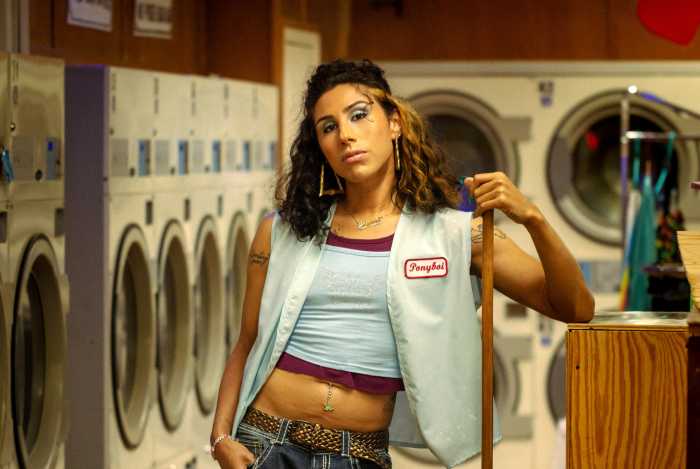Although a clever, versatile performer, Maneca needs guidance
BY GUS SOLOMONS, JR. | MACHO MAN Fernando Maneca dances at HERE. Videotaped interviews of people answering the question, “What is a real man?” separate the live sections of Fernando Maneca’s Just Like a Man, seen at HERE Arts Center (December 12-22). Men, women, and a little boy who gets tangled in his own thoughts, don’t really answer the question but express their personal opinions about men. In between, Maneca dances and tells, as the subtitle of this extended solo states, “personal anecdotes, confessions, and other tall tales.” Guest choreographers choreographed some of the vignettes. Not only does Maneca dance he also wrote some of the music and text, designed the sound, and made the video. His work blends these elements in a way that allows them to modify each other without conflicting. Zoë Klein’s nicely modulated lighting illuminates the action but doesn’t obscure the projections. Fragmentary sections show us tantalizing bits of motion or narrative, but they don’t develop to a punch line. Maneca scrabbles on the floor then swaggers to western movie music for Karen Bernard; he wrestles with a leaf rake for Shannon Hummel to a sentimental Italian tune; Aviva Geismar gives him alternately lyric and martial movement to Ravel music. But Maneca is most assured and interesting doing his own Capoeira-influenced movement in the “In a Dark Wood” section. In “Little Blue Ball” he convinces us that he’s forgotten his prop and after getting flustered he resorts to a verbal explanation of what he would’ve done with the forgotten prop: label various parts of his body with paper stickers. In Middle Finger, he cringes at being called “faggot” by unseen toughs; then fumes. “All the Girls,” co-written with Wayland Quintero, is a biography of sex acts he’s performed with women whose names appear on screen with the year of their encounters. “In 1981, Heather was fascinated with making his penis hard; he and Rebecca screwed backstage at The Nutcracker in 1984. He married Sheila in 1989, but she got leukemia and died. Tammy, 1990, admired her own very long neck; and so on… Every year for seven years, starting in 1992, he asked Vanessa to marry him; she finally said yes, the eighth.” Maneca comes off as a refreshingly non-stereotypical hetero guy: no jock allusions, no burps, farts, or gratuitous cursing. The evening begins with Today I Am Feeling A Bit Less Cynical, Maneca’s lively essay for himself and six women, in which he’s a young executive performing on video his morning ablutions, then heading, live, for work on the subway. En route, he turns into a homeless person, tearing letters out of newspapers and from his own newspaper-and-tape T-shirt to spell A-M-E-X. The press release explains that it’s intended “to unravel the truths behind a materially obsessed society.” The piece doesn’t unravel anything, and because the audience hasn’t a reviewer’s access to the press release for clarification. The choreographer’s intention remains on the page.

































